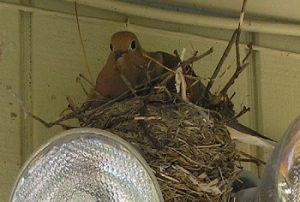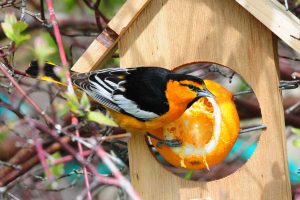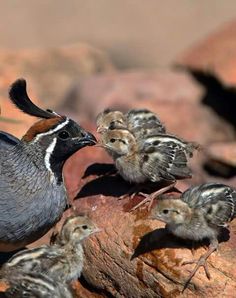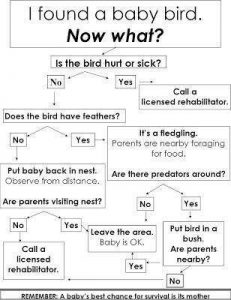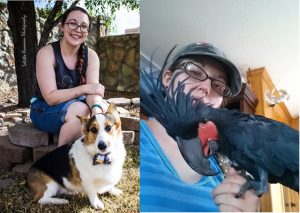The cold winter has ended, and we are in full bloom for a gorgeous spring season. With this changing of the season, we are not only going to see the beautiful colors of blossoming flowers, but also the colors of fabulous plumage on our wild birds. Many different birds are migrating in from their winter territories to travel up north to their nesting grounds and summer homes. Many of our yearlong residents are even changing their colors in preparation for this lovely season. The reason why many of these birds are changing colors and heading this way is for nesting. The bright plumage and various singing patterns help these birds find mates. Soon after the birds pair up, they will settle down and, based on their unique instincts, begin to nest, lay eggs, and raise their young.
For many birds, this system may occur only once per season or it can happen multiple times through several broods of chicks. Each species of birds is special and they all have their own unique methods when it comes to nesting season, but knowing who is nesting, what will be happening, and where to look for these nesting birds will help us enjoy our feathered friends during this season. We can even help their growth! This article will discuss the different types of birds that we may expect to see here in the Las Cruces area, as well as different backyard feeding that we can offer to increase the chances of viewing these colored beauties and seeing their young hatchlings.
Hummingbirds
One of our all-time favorite migrators has to be hummingbirds. These fleeting birds with brightly colored feathers are some of the most popular birds at our backyard bird feeders. So simple and easy to feed, it’s a breeze to catch a glimpse of one from your flower bed or nectar hummingbird feeders. Hummingbirds begin migrating back up through our area by mid-March from their winter habitats in Central and South America. Over 330 hummingbird species have been identified in the Americas, but only about 16 of these species will travel up through North America. The species that travel north do so in search of their nesting sites. As they travel this long journey, hummers will continuously be looking for food. A hummingbird will be able to drink at least 2 times their body weight per day. Offering nectar is a great way to assist these hungry hummers and give you a chance to view them more closely. It is also very easy to make your own nectar at home instead of constantly purchasing it.
The recipe is: 4 cups of boiling water mixed with 1 cup of regular table sugar. Just stir the sugar into the boiled water until the sugar is dissolved and then let the nectar sit until room temperature before filling the feeder.
Use feeders that have either red flowers or red lids instead of nectar dyed red. Hummingbirds can only see the color red, so many stores sell premade nectar that is dyed red. This can be much more harmful to the birds. It is best to stick with clear nectar and red feeders than to risk harming the birds with food coloring.
Features to look for when purchasing a hummingbird feeder include:
- Red coloration
- Easy to clean (must be cleaned before refilling to prevent bacteria)
- Easy to fill
- Easy to hang
- The nectar ports should be above the nectar surface to preventing dripping
- Ability to add an ant moat or other deterrent to prevent ants from entering your feeder
The main species of hummingbirds we will spot in and around Las Cruces are: Broad-tailed Hummingbirds, Black Chinned Hummingbirds, Anna’s Hummingbirds, Rufous Hummingbirds (arriving in July), Calliope Hummingbirds, and Magnificent Hummingbirds. Offering a hummingbird feeder and having flowering plants will help you attract hummers to your yard. Displaying a nesting ball made of natural cotton and other nest-safe materials will help the female hummers build a nest. If you see a female hummingbird collecting nesting material, you will see her immediately fly back to her nest site and you might be able to watch the young hummers grow.
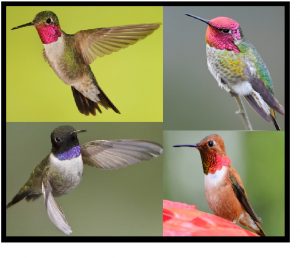
Four common male Hummingbird species found in New Mexico: Top Left: Broad-Tailed Hummingbird Top Right: Anna’s Hummingbird Bottom Left: Black Chinned Hummingbird Bottom Right: Rufous Hummingbird
Orioles
Orioles are very shy birds, and they are also very colorful. The males will show off bright orange or yellow plumage and will sing a sweet song high up in the tree tops. Orioles travel up from Central and South America to our area by early April to mate and nest. Orioles are very fond of places with tall trees and plants in wide open areas. Places like parks or backyards with a few tall trees interspersed with open fields and a steady water source are their favorites. About the size of a robin, orioles really enjoy nectar, fruit, and insects. It is possible to see an oriole drink the same nectar as hummingbirds from a hummingbird feeder. You can always purchase a separate feeder specifically designed for orioles. These will be orange versus the typical red of hummingbird feeders.
The nectar recipe for orioles is the same as hummingbird nectar due to the high chance of a hummingbird drinking from an oriole feeder. Some references will state that orioles like less sugar in their nectar than hummingbirds but, if a hummingbird accidentally drinks this nectar, it will be quite detrimental for them. There is no harm involved for an oriole to drink a slightly higher concentration of sugar.
Fruit is also a great attracter to orioles. Displaying an orange cut in half with the juice side up in a wide-open space where the flying bird may see it is an excellent way to attract orioles to your yard. The bright fruit and juicy pulp of an orange is one of the oriole’s favorite treats. By putting these oranges out by late March and in the beginning of April, the first oriole migrators will want to stop by to re-energize in your yard! Other treats that orioles love include grape jelly, fruit or bug flavored suet, and live mealworms.
The orioles that nest in our area include: Bullock’s Orioles (West side of town), Scott’s Orioles (East side of town), and sometimes Hooded Orioles. An oriole’s nest is shaped like a hanging sock. A very intricate construction, their nests can be hard to spot as they are precariously hidden towards the top of a tree and then may not even be seen until autumn. When an oriole nests in your area, they may very well come back year after year. The oriole you see today might just be the same one who visited you last year.
Western Kingbirds
While not a feeder bird, western kingbirds are always an exciting sight when they arrive. Migrating up from Central American wintering habitats, the western kingbird is looking for nesting sites in open plain areas. Commonly seen perching on trees and wires, the western kingbird will show off their bright, lemon-yellow belly and soft grey backs. While these birds will not be enticed by any birdfeeders in your yard, other factors will attract them. An outdoor water source such as a birdbath or pond is a great attracter. The water will attract all sorts of birds, especially out here in the New Mexico desert. All living things need water and, when in an arid environment, many different creatures, such as insects, will flock to a water feature. Kingbirds love to eat insects. They are quite a sight to enjoy when they are chasing down their prey. Preforming amazing aerial acrobatics displays, kingbirds are a very entertaining summertime visitor.
Resident Nesting Birds
Many of our local desert birds will not leave our general area for nesting, and it can be very exciting to watch them courting and raising their young. We can always help out these birds by offering foods that are high in calcium. This will help the males color their feathers, it will produce higher quality egg shells, and it will later assist chick bone growth. It is very easy to find healthy foods that are high in calcium. Many different kinds of suet will have calcium added to it. If you’re struggling to find food with calcium, try offering eggshells. Eggshells from your regular grocery store eggs are an excellent source. To prepare the egg shell for your birds, you will first need to sterilize them. Rinse the empty eggshells thoroughly with water, then place them on a cookie sheet and bake them at 250°F until the shells are dry and brittle. You may then crumble the baked egg shells and display them on a flat surface outside for the birds to find.
Our local birds that are very active right now include: quail, doves, mocking birds, and the lesser goldfinches.
Quail
Quail are currently establishing territories and nesting. The male quail will stand on a wall or tall branch singing his loud call to notify other quails of his established territory. The female will incubate her eggs in a shallow nest hidden on the ground for about 21 to 31 days. After the quail chicks hatch, they need to learn how to walk and run very quickly so they don’t become vulnerable prey. The quail chick’s development is much faster than that of other birds because they are able to forage and eat their own food just days after hatching. Other avian species are dependent on the parents to provide food. As the quail chicks grow, they will continue to stay with their parents and other quail to form a group called a covey and they are commonly seen walking in a single file line.
Doves
Doves have adapted to our cities and our suburban environments and they can (and will) build their nests just about anywhere. The main dove species that we will commonly see nesting here in Las Cruces are Rock Doves (which are also known as pigeons), White-Winged Doves, and Mourning Doves. A dove’s total time in a nest from incubation to fledging will be about 40 days. The dove chicks are completely dependent on their parents when they first hatch. Young doves will commonly fall out of nests when first learning how to fly. The best thing to do when spotting a fallen chick is to leave it alone and wait to see if the parent is nearby. Just like learning to walk, they may have to fall a few times before learning to fly. Offering a seed blend that is high in millet scattered on the ground or in a ground tray will really help these nesting birds!
Mockingbirds
When mockingbirds are looking for a mate, the male will first establish a territory and then find the highest perch within his territory where he begins to sing. To attract a female, the male mockingbird will sing all day and all night. Sadly, there is not much we can do to assist the lone bachelor, but we hope he doesn’t choose to sit outside our windows to sing his lonely song at night.
Goldfinches
Goldfinches join the mockingbird as birds who make a display for the females. The lesser goldfinches are a non-migratory inhabitant of our desert. Known for their gorgeous yellow plumage, the goldfinch will only display this colorful array twice a year and will otherwise wear a more olive-yellow plumage. The goldfinch will molt in the early spring to their much more vibrant name sake as this helps the male attract a mate. Offering fresh nyjer (thistle) seed in your feeders will help these birds have brighter and more colorful feathers.
Discovery is the thrill of the hobby of birdwatching! Many different bird species will increase their activity during this spring and summer. You can attract and view both the migrators and permanent bird residents by providing appropriate nectar, food or nesting materials in your yard.
Ashley Gurnea, our Avian Editor, is a certified bird feeding specialist at Wild Birds Unlimited. A graduate from New Mexico State University, Ashley earned her bachelor degree in the field of Animal Science. She completed an internship at an exotic animal park, working with animals ranging from camels to porcupines and a variety of birds such as parrots and cockatoos. This love and curiosity of aviary has led her to her current position at Wild Birds Unlimited in Las Cruces where she remains up to date with local wild feeder birds. Growing up in a home where animals have always been present, Ashley is now a self-proclaimed “Corgi Countess” due to her love and adoration for her tricolor Pembroke welsh corgi, Colin. Bring up anything corgi or bird related in a conversation and Ashley will be happy to share her many photos. Feel free to ask her about pet birds, and visit Wild Birds Unlimited for questions on wild birds! Ashley can be reached at ashleygurnea@gmail.com.

